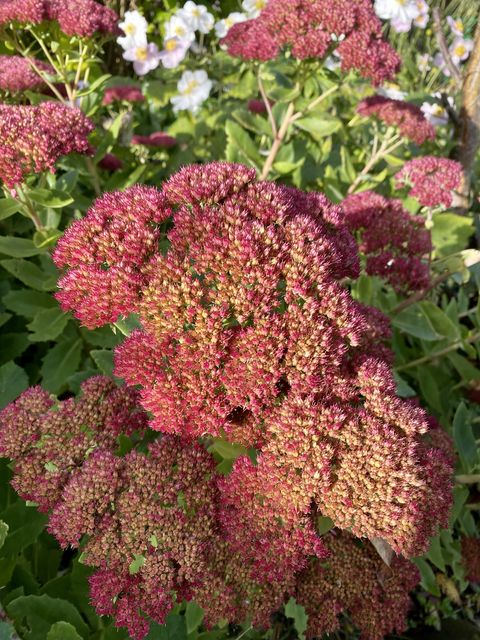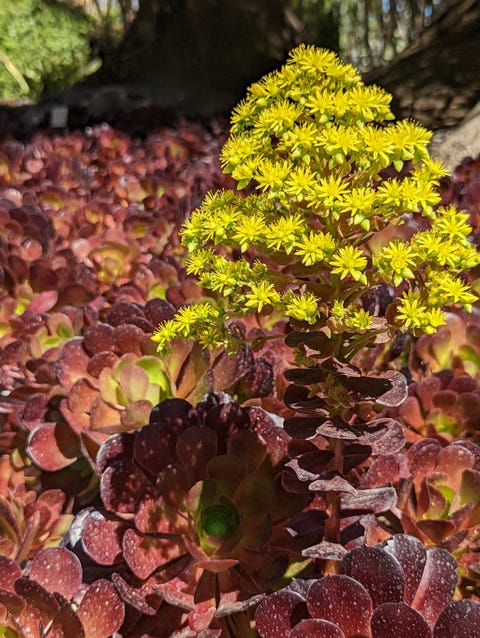Succulents (a group which includes all our favorite cacti) come in all textures, sizes, and shapes. They’re unique plants that are easy to grow both indoors as houseplants and outdoors in your garden (Here’s our complete succulent growing guide.)
Many have striking flowers that make them even more appealing to grow. Because they retain moisture in their fleshy leaves, stems, and roots, they don’t need to be watered as often as many other plants. That makes them ideal for new plant parents or if you’re, ahem, a wee bit forgetful about watering! (Here are some other low-maintenance flowers for the lazy gardener.)
The biggest challenge with succulents is giving them the right conditions. They need tons of bright light indoors, so you may need a grow light if you don’t have sufficient natural light. Outdoors, most succulents enjoy full sun, which is typically 6 or more hours of direct sunlight per day. But always read the plant tag or description to be sure you’re giving your plant the light it requires.
Above all, remember that, just like cacti succulents do not tolerate being overwatered and will quickly turn to mush if you water them too frequently. Give succulents a drink only when the soil is mostly dry. Before watering, stick your finger in the soil; if it feels damp and soil sticks to your finger, hold off and recheck in another few days. It’s generally better to err on the side of too dry, rather than too wet when it comes to these plants. (Ready for more? Here’s how to propagate your succulents.)
Ahead, our favorite flowering succulents for your home and garden:

Kalanchoe
Kalanchoe is a pretty, sturdy plant with red, pink, orange, yellow or white flowers that last for weeks and weeks. It can be tough to get it to rebloom, so it’s often treated as a gift plant and composted after the blooms fade. Give it bright light, and water when it feels mostly dry.
 Hermsdorf//Getty Images
Hermsdorf//Getty ImagesDelosperma
Delosperma, also known as ice plant, is a perennial groundcover that tolerates heat and drought once established. It’s great for erosion control because it spreads quickly. Give it full sun.
Incidentally, delosperma shouldn’t be confused with highway ice plant (with the botanical name, Carpobrutus). That’s actually an invasive species.

Sedum
There are many different types of sedums in both upright and low-growing varieties. This perennial comes in various shades of pink and rarely needs anything other than divided when it gets too big for the spot. Make sure sedum has full sun.
 Meagan Widrick//Getty Images
Meagan Widrick//Getty Images
Portulaca
Portulaca, also called moss rose, is a low-growing annual that’s absolutely covered in blooms every day for weeks and weeks. It’s also easy to grow from seed. The delicate flowers come in the most amazing, saturated shades ranging from hot pink to deep coral. It needs full sun.

Lewisia
This alpine wildflower is native to western North America and is surprisingly cold-hardy. It has dark green leaves and beautiful apricot, pink or white flowers atop long stems in spring and summer. Give it full sun.
 NNehring//Getty Images
NNehring//Getty ImagesEcheveria
There are many different types of echeveria, but they all have a beautiful rosette-shape with fleshy foliage tinged with shades of teal, dove grey, green or pink. When they flower, they have long stems lined with bell-shaped blooms. They can be grown as houseplants or in the garden in frost-free zones. This perennial likes full sun, but in hot climates, give it some afternoon shade.

Aloe Vera
This handsome succulent is often grown as a houseplant. But in warm climates, it can be grown in the landscape where it will reach 3 feet tall and send up spikes of yellow flowers. It needs full sun and won’t tolerate freezing temperatures.
 Reems Sonson//Getty Images
Reems Sonson//Getty ImagesCrown of Thorns
Crown of thorns can bloom almost non-stop indoors. It has large, sharp spines (thus, the name!), so be careful with this plant around kids or pets. The sap also can be irritating. Give it as much bright light as possible for best blooms.

Jade Plant
Jade plant is one of those sturdy houseplants that’s been around forever. It has fat, oval leaves, and some types have red margins. It’s tough to get this one to bloom, but if your home is very dry, you may get lucky. It also needs cool nights around 60 degrees. It’s said that if you get jade to bloom, it brings good luck! If all that seems like too much effort, enjoy its handsome tree-like form.
 kundilokphoto//Getty Images
kundilokphoto//Getty Images
Old Lady Cactus
It’s not a very flattering name, but this cactus is one of the easier ones to grow indoors. It has a rounded shape with a fuzzy-looking texture. It develops a ring of hot pink flowers in late winter to early spring. Set it on a sunny windowsill.

String of Pearls
The delicate beads on this succulent look exactly like a pearl necklace. It’s grown indoors — and is one of our favorite houseplants. It gets round white flowers in summer if given cold nights and warm days and allowed to dry out slightly—though that can be tough to achieve in most homes. Give it bright, indirect light.
 Gail Shotlander//Getty Images
Gail Shotlander//Getty ImagesSempervivum
This hardy, old-fashioned perennial also is known as hens and chicks because of the baby plants, or “chicks,” that pop up around the mother plant. Tiny, starry blooms appear in midsummer. Interestingly, the plants are monocarpic, which means once they flower, they die! But it’s all part of the natural process, and the baby chicks will go on to bloom in a year or two. It needs full sun.

Holiday Cactus
Christmas cactus (as well as similar plants that bloom around the time of Thanksgiving and Easter) can live for decades. They are reliable, hardy succulents that needs little care. These plants require bright indirect light for most of the year.
To get them to rebloom, place them in a room that receives no nighttime light starting in September because they require 12 to 14 hours of complete darkness to set buds.
 Post_Insignem//Getty Images
Post_Insignem//Getty ImagesAeonium
Glossy leaves arranged in rosettes make this plant a pretty perennial that grows both indoors and outdoors in warm climates. Small star-shaped flowers grow from the center of the clusters. Give it very bright light indoors and part shade outdoors.

Desert Rose
With adorable, pudgy stems and a bulbous base that holds water, this attractive plant has bright pink blooms in summer. It can be grown as a houseplant, but you’ll probably need a grow light to help it bloom. Outdoors in frost-free zones, it needs full sun.
 areeya_ann//Getty Images
areeya_ann//Getty ImagesPeanut Cactus
This cute clumping cactus is fairly easy to grow indoors, or grow it outdoors in full sun in frost-free zones. It looks exactly like its name, with stems that can curl up to 12 inches long. The spines are softer than some cacti, and this plant may develop bright orange flowers. Give it lots of bright light.
 Douglas Rissing//Getty Images
Douglas Rissing//Getty ImagesHoya Carnosa
This pretty succulent, also know as wax plant, has shiny leaves and sweetly-scented flowers. It needs very bright light to bloom.





